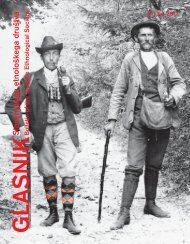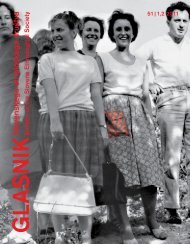52 Glasnik SED 49|3,4 2009 Razglabljanja Jaka Repič DELEUZE, Gilles in Felix Guatari: Rizom. Književna kritika: časopis za književna i estetička pitanja 21(1), 1990, 7–26. ERDENTUG, Aygen in Freek Colombijn (ur.): Urban Ethnic Encounters: The Spatial Consequences. London: Routledge, 2002. ESCOBAR, Arturo: Welcome to Cyberia. Current Anthropology 35(3), 1994, 211–231. FRIEDMAN, Jonathan: From Roots to Routes: Tropes for Trippers. Anthropological Theory 2(1), 2002, 21–36. GLICK SCHILLER, Nina: The Situation of Transnational Studies. Identities 4(2), 1997, 155–166. GLICK SCHILLER, Nina, Linda Basch in Cristina Szanton Blanc (ur.): Towards a Transnational Perspective on Migration: Race, Class, Ethnicity and Nationalism Reconsidered. New York: New York Academy of Sciences, 1992. GLICK SCHILLER, Nina in Linda Basch: From Immigrant to Transmigrant: Theorizing Transnational Migration. Anthropological Quarterly 68(1), 1995, 48–63. GUPTA, Akhil in James Ferguson (ur.): Anthropological Locations: Boundaries and Grounds of a Field Science. Berkley, Los Angeles in London: University of California Press, 1997a. GUPTA, Akhil in James Ferguson (ur.): Culture, Power, Place: Explora tions in Critical Anthropology. Durham in London: Duke University Press, 1997b. GUPTA, Akhil in James Ferguson: Beyond »Culture«: Space, Identity, and the Politics of Difference. V: Akhil Gupta in James Ferguson (ur.), Culture, Power, Place: Explorations in Critical Anthropology. Durham in London: Duke University Press, 1997c, 33–51. GUPTA, Akhil in James Ferguson: Discipline and Practice: »The Field« as Site, Method and Location of Anthropology. V: Akhil Gupta in James Ferguson (ur.), Anthropological Locations: Boundaries and Grounds of a Field Science. Berkley, Los Angeles in London: University of California Press, 1997d, 1–46. HANNERZ, Ulf: Cultural Complexity: Studies in the Cultural Organization of Meaning. New York: Columbia University Press, 1992. HANNERZ, Ulf: Transnational Connections: Culture, People, Places. London in New York: Routledge, 1996. HANNERZ, Ulf: Flows, Boundaries and Hybrids: Keywords in Transnational Anthropology, www.transcomm.ox.ac.uk/working%20papers/hannerz. pdf, 1997. HANNERZ, Ulf: Transnational Research. V: H. Russell Bernard (ur.), Handbook of Methods in Cultural Anthropology. Walnut Creek, Lanham, New York in Oxford: Altamira Press, 1998, 235–256. HARRISON, Simon: Fracturing Resemblances: Identity and Mimetic Conflict in Melanesia and the West. London in New York: Berghahn, 2008. HERVIK, Peter: Anthropological Perspectives on the New Racism in Europe. Ethnos 69(2), 2004, 149–155. KEARNEY, Michael: The Local and the Global: The Anthropology of Globalization and Transnationalism. Annual Review of Anthropology 24, 1995, 547–565. KEESING, Roger M.: Ponovno o teorijah kulture. Antropološki zvezki 3, 1993, 23–32. KLINAR, Peter: Mednarodne migracije: sociološki vidiki mednarodnih migracij v luči odnosov med imigrantsko družbo in imigrantskimi skupnostmi. Maribor: Obzorja, 1976. LEACH, Edmund: Political Systems of Highland Burma: A Study of Kachin Social Structure. London: Athlone, 1954. LEWIS, Oscar: La Vida: a Puerto Rican Family in the Culture of Povert – San Juan and New York. New York: Vintage books, 1968. LOON, van Joost: Social Spatialization and Everyday Life. Space and Culture 5(2), 2002, 88–95. LOW, Setha M. in Denise Lawrence-Zúniga (ur.): The Anthropology of Space and Place: Locating Culture. Malden, Oxford in Carlton: Blackwell, 2003. MARCUS, George E.: Ethnography in/of the World System: the Emer gence of Multi-sited Ethnography. Annual Review ˜ of Anthropology 24, 1995, 95– 117. MCLUHAN, Marshal: The Global Village. New York in Oxford: Oxford University Press, 1992. MITCHELL, J. Clyde: Social Networks in Urban Situations. Manchester: Manchester University Press, 1969. MURŠIČ, Rajko: Trate naše in vaše mladosti: zgodba o mladinskem in rock klubu. Ceršak: Subkulturni azil, 2000. MURŠIČ, Rajko: Nova paradigma antropologije prostora: prostorjenje in človeška tvornost. Glasnik S<strong>lovenskega</strong> <strong>etnološkega</strong> <strong>društva</strong> 46(3/4), 2006, 48–54. OLWIG, Karen Fog: Sustaining a Home in a Deterritorialized World. V: Karen Fog Olwig in Kirsten Hastrup (ur.), Siting Culture: The Shifting of Anthropological Knowledge. London in New York: Routledge, 1997, 17–38. OLWIG, Karen Fog: New York as a Locality in a Global Family Network. V: Nancy Foner (ur.), Islands in the City: West Indian Migration to New York. Berkely, Los Angeles in London: University of California Press, 2001, 142–160. PORTES, Alejandro: Immigration Theory for a New Century: Some Problems and Opportunities. International Migration Review 31(4), 1997, 799–825. PORTES, Alejandro: The Study of Transnationalism: Pitfalls and Pro mise of an Emergent Research Field. Ethnic and Racial Studies 22(2), 1999, 217–237. POVRZANOVIĆ Frykman, Maja: Transnational Perspective in Ethnology: From »Ethnic« to »Diasporic« Communities. V: Maja Povrzanović Frykman (ur.), Transnational Spaces: Disciplinary Perspectives. Imer: Malmö University, 2004, 77–100. REPIČ, Jaka: »Po sledovih korenin«: Transnacionalne migracije med Argentino in Evropo. Ljubljana: Filozofska fakulteta, 2006. REPIČ, Jaka: Shifting Homes and Identities: Being Slovenian in Argentina and Argentinean in Slovenia. V: Jaka Repič, Alenka Bartulović in Katarina Sajovec Altshul (ur.), MESS and RAMSES II. Vol. 7, Mediterranean Ethnological Summer School. Ljubljana: Znanstvena založba Filozofske fakultete, 2008, 169–185. SAFRAN, Wiliam: Diasporas in Modern Societies: Myths of Homeland and Return. Diaspora 1(1), 1991, 83–99. SHEPER-HUGHES, Nancy: The Global Traffic in Human Organs. Current Anthropology 41(2), 2000, 191–211. STOLCKE, Verena: Talking Culture: New Boundaries, New Rhetorics of Exclusion in Europe. Current Anthropology 36(1), 1995, 1–24. VERTOVEC, Stephen: Conceiving and Researching Transnationalism. Ethnic and Racial Studies 22(2), 1999, 447–462. VERTOVEC, Stephen: Transnationalism and Identity. Journal of Ethnic and Migration Studies 27(4), 2001a, 573–582. VERTOVEC, Stephen: Transnational Social Formations: Towards Conceptual Cross-fertilization, http://www.transcomm.ox.ac.uk/working%20papers/ Vertovec2.pdf, 2001b. WALLERSTEIN, Imanuel: The Modern World System: Capitalist Agriculture and the Origins of the European World Economy in the Sixteen-Century. New York, London in San Francisco: Academic Press, 1974. WIKAN, Unni: Generous Betrayal: Politics of Culture in the New Europe. Chicago: University of Chicago Press, 2002. WILSON, Thomas M. in Hastings Donnan (ur.): Border Approaches: Anthropological Perspectives on Frontiers. Lanham: University Press of America, 1994. WILSON, Thomas M. in Hastings Donnan (ur.): Border Identities:Nation and State At International Frontiers. Cambridge: Cambridge University Press, 1998. WIMMER Andreas in Nina Glick Schiller: Methodological Nationalism and beyond: Nation-state Building, Migration and the Social Sciences. Global Networks 2(4), 2002, 301–334.
Razglabljanja Jaka Repič The Methodology of Ethnographic Research of Migration and Transnational Processes In the Introduction of his work Transnational Connections: Culture, People, Places Ulf Hannerz strongly emphasizes a generally wellknown fact that the current world of global connections is different than it was in the past. Since mobility, global cultural currents, and trans national connections have increased an interest in cultural and social dynamics, in identity processes, in cultural changes, and in hybridity these are among the central issues explored by anthropology. Studies of different kinds of human mobility, particularly of migrations and transnational connections, have in the late 1980s, and particularly in the 1990s, become a very significant (and frequent) subject of anthropological research; however, they generally lacked solid theoretical foundations. It was because of this that a number of authors started to suggest that in order to study such phenomena anthropology needs to alter its research methods and introduce some new (and »new old«) concepts. This, in turn, calls for a reexamination of the organization of anthropological studies, particularly (but not exclusively) those dealing with mobility, migrations, and transnational connections. Some ethnographic studies of mobility and transnationality have partly abandoned classical research and analytical methods. George E. Marcus suggests that these phenomena cannot be studied in only one location on the grounds that a sole manifestation of a certain phenomenon is much less interesting than its interaction with the »world system«, global currents, transnational connections, and social networks. He proposed ethnographic research in several places, which, of course, can become much more complex than classical localized ethnography. A similar model was proposed by Arjun Appadurai who used the concept of landscapes to describe the extent of global cultural currents. Modern migrations and global and transnational currents represent an important segment of human mobility. In the past, migrations depended upon socioeconomic regulations of nation states and the related global processes such as (post)colonialism. Modern migrations are much more transnational. They represent global mobility of people that depends upon global inequality of capital and of economy and sociopolitical relations among nation states. This mobility is connected with the question of identities, citizenship, nationality, culture, migration policies, integration, multiculturalism, social exclusion, and so on. International and transnational migrations and other forms of human mobility that have been taking place during the last few decades have become an important global phenomenon – and may even denote a »transnational revolution« (Castles and Miller 2003). While he was doing research of transnational connections between Argentina and Slovenia and their impact upon the process of identity the author of this article was forced to reexamine certain methodological issues. This text presents certain theoretical concepts and methodological approaches that can be used in anthropological research of migration processes and transnational currents, and some key authors who have explored these issues. 53 Glasnik SED 49|3,4 2009




